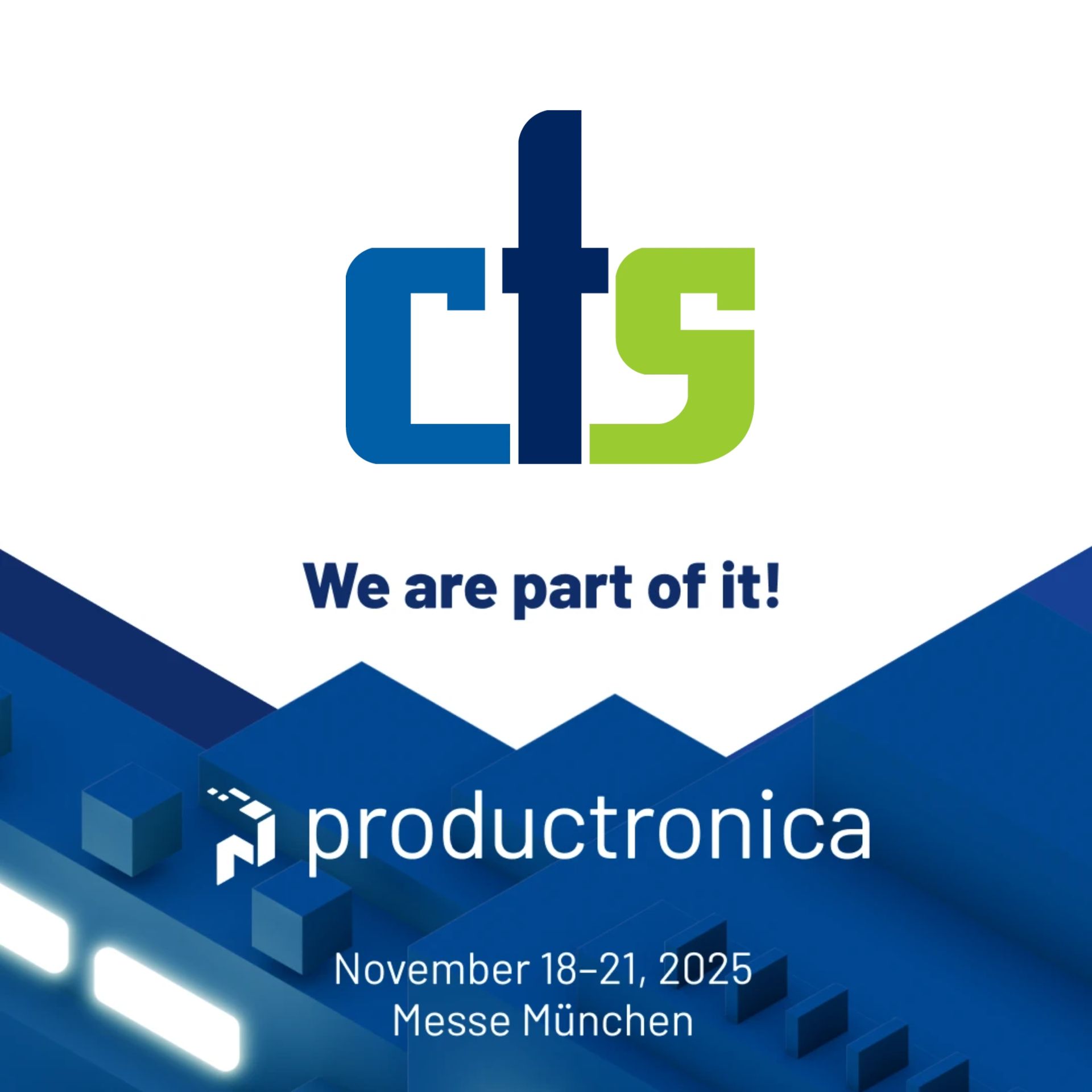CTS in Conversation: Smart Warehouses, Material Flow and Automation in SMT Manufacturing


Automation, material flow, smart warehouse
At Productronica 2025, CTS will be talking about the future of material flow. Taking center stage: Alfred Pammer, VP Sales, Marketing & Product Management. For years, he has been helping electronics manufacturers bring intralogistics and production closer together. In this interview, he explains why the perfect one-piece flow often fails in practice - and how smart warehouse solutions with warehouse automation and AMRs solve space problems, create transparency, and keep manufacturing competitive.
Focus: Smart electronics factory, warehouse automation, AMRs
Many customers struggle with limited space in their production facilities. What specific problems does the Smart Warehouse solve for SMT manufacturing companies?
In theory, it looks simple: a perfect one-piece flow eliminates the need for intermediate storage. In practice, however, manufacturers know that this ideal situation is almost impossible to achieve. Flat assemblies have to be stored between processes - and that is precisely what causes problems. “Not only does this create additional manual work, but it also wastes production space and leads to tedious searches afterwards,” explains Alfred Pammer.
This is where the Smart Warehouse comes in. It takes care of the automatic storage, management, and traceability of materials – in a space-saving and compact way. The key factor here is that materials are provided or collected at the pace of production without causing any delays.
Pammer describes the smart warehouse as a “fully automated distribution center”: with algorithms that ensure ideal distribution of materials and interfaces that create transparency. “Higher-level ERP or warehouse systems know at all times which materials are located where and when they entered or left the warehouse.”
Why is the synchronization of warehouses, AMRs, and production lines often the real bottleneck today—and how do you solve this technically?
Many manufacturers invest in state-of-the-art machinery – and still experience delays. The reason for this rarely lies in production itself, but rather in the interaction of logistics processes. “Material flow automation does not work in isolation,” emphasizes Pammer. “Automation only unleashes its full potential when warehouses, AMRs, and production lines communicate with each other in a structured and clearly defined manner.”
CTS's smart warehouse solutions are therefore not only physically networked, but also digitally connected. They feature a warehouse management system equipped with state-of-the-art interfaces as well as AMR-enabled storage and retrieval ports. This enables just-in-time and just-in-sequence supply – without manual intervention.
A central element is the in-house middleware sloXis. It acts as a data hub that connects transport systems and at the same time allows fast connection to MES or ERP systems. “This gives us the flexibility to respond to specific customer requirements while still ensuring smooth integration,” says Pammer.
What role does tracking play in warehousing for quality assurance and traceability in electronics manufacturing?
Traceability does not end at the machine. If you want to reliably prove quality, you also need to document transport and temporary storage seamlessly. “In order for customer MES systems to be able to map complete traceability, it is important to track not only the individual production processes, but also transport between processes and thus also temporary storage,” emphasizes Pammer.
This is exactly what the CTS warehouse management system does. “All storage and retrieval processes are logged and securely stored, ensuring complete traceability of products at the customer's site. If required, all processes can also be sent to a customer's ERP system.”
The sloXis middleware forms a second level. “It logs all transports carried out by AMRs – from order receipt to completion. This means our customers know at all times where each material is located and how it got there.”
How do you ensure that the smart warehouse integrates seamlessly into existing factory layouts and systems?
A common bottleneck in SMT manufacturing is space: machines need room, and temporary storage blocks valuable production areas. “Our smart warehouses are therefore designed to be flexible in terms of height – and the Big model even in terms of length,” explains Pammer. “This allows the available room height and depth to be used optimally.”
The input and output ports are also not fixed, but can be placed where they best support the material flow. “The number of ports is variable. This allows our customers to regain production space that would simply be lost with manual storage.”
The integration does not end with the layout. “On the software side, the connection is made via state-of-the-art interfaces, which we can adapt to customer requirements or existing systems thanks to our proprietary WMS,” says Pammer.
Production managers want throughput, CFOs want cost certainty, quality managers want traceability - how do CTS systems address these different requirements simultaneously?
In SMT manufacturing, different expectations often clash: production managers push for maximum throughput, CFOs for cost certainty, and quality managers for complete traceability. “There is no rule of three that makes everyone 100 percent happy,” Pammer says candidly. “In the end, it's like everywhere else—compromise is the solution.”
For production managers, this means that the path to the final target situation sometimes takes a little longer because investments are spread out over phases. The CFO, on the other hand, benefits precisely from this approach: “Implementation in phases creates cost certainty – with the flexibility to delay or bring forward individual steps.”
And the quality managers? “They are usually the ones who benefit the most,” says Pammer with a smile. “Quality does not allow for compromises – we deliver that from the outset.”
What role will modular storage solutions play in the future—more as an “add-on” or as a standard component for every electronics manufacturing facility?
Will modular storage solutions become standard in the future? Pammer rejects hasty labels. “It's definitely not an add-on - that wouldn't do justice to the topic. But it's not standard either,” he says. Ultimately, each production facility must be considered individually and the benefits evaluated.
It doesn't make sense to use it in every line. “But where it has a positive impact, it always makes me smile,” says Pammer. Especially when he sees how far customers have come with implemented material logistics projects: “That makes me very positive about their competitiveness.”
Focus: Warehousing & Intralogistics
In many factories today, employees still move PCB magazines across the hall. What typical errors does this cause - and how exactly does the smart warehouse prevent these situations?
This scene is still commonplace in many electronics factories: employees pushing PCB magazines through the hall by hand. For production managers, this not only means wasted space, but also unnecessary stress in the process. “Unstructured storage leads to increased manual effort, materials have to be handled multiple times, they are more easily lost – and in the end, the line still has to run,” Pammer explains.
The result: employees juggle between value-adding and non-value-adding tasks – and lose focus. “All of this puts a strain on the operator, whose actual job is the line,” says Pammer.
Smart warehouse solutions put an end to this situation. "Automatic storage, management, and traceability – compact and space-saving. Connected to an automatic transport system, the right material is in the right place at the right time. The operator no longer has to worry about gathering or picking up material – it's simply there when he needs it."
The result: higher efficiency, increased quality – and employees who can once again concentrate on what really matters: the line.
Focus: Cooperation in projects
At Productronica 2025 you will be appearing together with AdoptSMT and FlexLink. How does the Smart Warehouses fit into this joint line?
"A warehouse alone cannot solve all problems – just as a company cannot solve all problems. But together, we have many more opportunities to offer our customers turnkey solutions. With loaders/unloaders, buffers, and lasers for SMT lines, FlexLink covers a large part of the necessary machinery for an SMT line, and we supply these directly from our warehouses with our AMRs. AdoptSMT is the first port of call for PCB magazines, consumables, and feeders - all essential materials for keeping a line running.

Many projects fail at interfaces: the machine supplier blames the conveyor technician, who blames the automation engineer. How do you ensure that this discussion does not arise in your company?
Hardly any project in electronics manufacturing fails because of the machine itself—most problems arise at the interfaces. If the machine supplier refers to the conveyor technician and the latter in turn refers to the automation engineer, the manufacturer is left with a stationary line.
“Such discussions cannot be completely ruled out in reality. The decisive factor is how you deal with them,” says Pammer. CTS's approach: maximum transparency. “Our interfaces are clearly defined and disclosed – whether at the hardware or software level.”
Workshops with all parties involved are a key tool. “At the latest at the start of the project, we sit down together to record all dependencies, information flows, protocols, and commands. This enables each party to proceed with implementation.” Even better: if this exchange takes place before the project starts. “Then the necessary adjustments can be clearly evaluated – and cost transparency is also created.”
The advantage of the partnership with AdoptSMT and FlexLink is that many interfaces have already been tested in previous projects. “This reduces friction and creates security because we don't have to start from scratch every time.”
When a line is in place: Who takes responsibility—and how do you organize this between AdoptSMT, FlexLink, and CTS?
Downtime is a serious matter in any SMT production facility – and that's exactly when it needs to be clear who is responsible for taking action. “Transparency is our top priority,” says Pammer. The customer can decide for themselves: either they choose a general contractor and have a single point of contact – with the corresponding conditions. Or they work with three parties in parallel and have a direct contact for each area.
The advantage of the three-way partnership with AdoptSMT, FlexLink, and CTS is that the partners work well together. “Because we know each other and work together as partners, it's easier for the customer – no matter which path they choose.”
From the customer's perspective: What is the tangible advantage of having three specialists in one team instead of three quotes and three contact persons?
Many contractors are familiar with the problem: three quotes, three contacts, three perspectives—and in the end, you have to coordinate everything yourself. The partnership between CTS, AdoptSMT, and FlexLink eliminates this risk.
“With a general contractor, the customer has only one contact person who coordinates all issues internally between the parties,” explains Pammer. For the customer, this means that they address everything to a central point and receive all information in a bundled form from there.
At the technical level, direct communication with the experts continues – and that makes sense. However, the responsibility for coordination and clarity no longer lies with the customer, but with the well-coordinated team.


